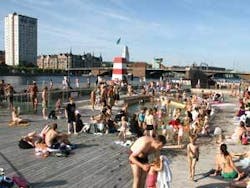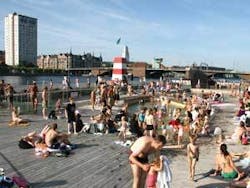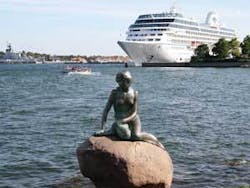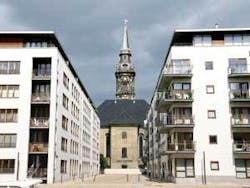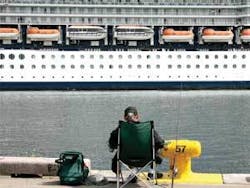Take a Refreshing Dip in the Harbour
Bathers can once again enjoy swimming in the Port of Copenhagen thanks to water quality management efforts of area municipalities and DHI Group.
The water in a large harbour or port isn’t normally very clean and taking a swim may not readily seem appealing. But, in the Danish Port of Copenhagen, thousands do it and enjoy it. The reason - the water is clean. Still, it hasn’t always been like this.
Fifty years ago, it was very common to swim in the harbour, which had a number of public bathing facilities. The advent of the water closet and industrial development changed this dramatically. The city’s untreated sewage was discharged directly into the harbour, making the water unhealthy for decades. As a consequence, the earlier popular public bathing facilities were closed one by one. Over the last one to two decades, this has changed dramatically and the water quality today has reached a level corresponding to bathing water quality.
Copenhagen’s sewer system is predominantly a combined system where mixed rainwater and raw sewage is transported to the two wastewater treatment plants, Damhusåen and Lynetten, established in 1930 and 1980, respectively. Both facilities are today fully modern plants and sewage is cleaned by mechanical, biological and chemical processes. The treated wastewater is finally transported 1.5 km out into the sound of Øresund where it’s diluted with seawater. The wastewater plants receive sewage and rainwater from Copenhagen and adjacent municipalities covering an area of about 123 km2.
In rare cases when capacity of the system is exceeded, diluted wastewater mixed with rainwater has to be discharged into the harbour. This influences the quality of the water for a period and, as a consequence, the quality may deteriorate to an extent where it exceeds regulatory criteria defined by environmental authorities and the EU Bathing Water Directive. To safeguard public health, the whole system is monitored carefully and, in the event of a release into the harbour, a four-day prognosis is made to determine the impact on water quality as well as duration of the event. Should the prognosis indicate water quality may drop below accepted criteria then the bathing facility will be shut down and reopened when quality again complies with required standards. This typically happens four or five times a year, depending on the level and intensity of precipitation. Bathing water status is disseminated via the Internet and a simple flag system. If a green flag is up, then you can jump in the water. If, on the other hand, a red flag is blowing in the wind, then it’s time to do something else - but then it’s most likely also windy and raining heavily. Normally, it takes a couple of days before the water quality is back to the desired level. The regulated flow of seawater through the port is such that periods with a red flag are rare and normally brief.
The concept of having a bathing facility in the harbour or port of a large city is really quite intriguing, but also clearly demonstrates that it’s possible to handle wastewater from a modern city if the right technology and management is implemented. It should in this context also be borne in mind that the Port of Copenhagen actually is a very busy port.
The bathing facility was established five years ago and has proved a tremendous success in attracting local residents who otherwise wouldn’t have the opportunity to take a refreshing swim in clean seawater. Three public bathing facilities are now available in Copenhagen and more are under way. The bathing facilities have been established by the municipality of Copenhagen, utilising a monitoring and prognosis system developed by the independent and Danish-based development and consulting firm DHI Group.
Though a success, there’s still more to do. A Swedish/Danish initiative in the Copenhagen/Malmø region is now looking at how to trace sources of pollutants which load the system. The idea is to remove or eliminate them before they enter the sewage system. This will ensure water treatment plants can operate even more efficiently as the sewage profile becomes narrower and more manageable. As a result, the treated wastewater dispersed at sea will become cleaner - thereby reducing the impact on the overall environment. Other initiatives include distributed treatment at the outlets with, amongst other measures, disinfection via exposure to UV light, which can kill bacteria quickly and efficiently.
Conclusion
The steps taken by Copenhagen and the suburbs clearly demonstrate it’s possible not only to curb pollution effects and years of neglect but also to re-establish the environment as it used to be and should be. The success is largely due to the fact that a number of municipalities have joined forces in a concerted effort to address these water quality issues and, as a consequence, have employed sound planning and management methods combined with proven technology. This further demonstrates how efficient decision support systems may be. Other municipalities and operators are becoming aware of the benefits to be gained, which has resulted in closer collaboration and new initiatives.
Author’s Notes:
Michael Macdonald Arnskov is marketing coordinator for DHI Group, which is based in Hørsholm, Denmark. Contact: +45 4516 9200, [email protected] or www.dhigroup.com
DHI in Denmark
A sample of DHI Group coastal engineering projects in Denmark (1999-2007):
- Sediment Transport and Coastal Morphology Study, The Skaw Spit - 1999- The sediment transport regime around the Skaw was investigated with 1D and 2D modeling tools, with expected shoreline evolution for the Kattegat coast mapped for various intervention scenarios.
- NOURTEC II - 1999 - Numerical modeling of coastal processes in the vicinity of a shoreface nourishment site.
- Kystcentret Thyborøn, Animations for Exhibition - 2000 - Created on basis of numerical model results from MIKE 21 and LITPACK.
- Sedimentological Investigations on the Influence of a Rubble Mound Protection of the Western Breakwater, Hanstholm Harbour - 2000-01 - Due to changed reflection patterns off the western breakwater, modelling was performed using MIKE 21 (EMS HD and ST).
- Thorsminde Port, New Brealwaters - 2003-04 - Plan layout of new protection structures for Thorsminde Harbour was optimised by use of 2D numerical modelling tools (especially MIKE 21 CAMS) to minimise sedimentation of the harbour entrance and maintain a safe minimum depth.
- Amager Beach Park, Master Plan and Detailed Design - 2003-05 - Municipalities in Greater Copenhagen created a new beach park on the island of Amager’s east side, which is very close to the centre of Copenhagen in a densely populated area. Design phase included preparation of tender documents and construction supervision, with DHI as subconsultant to NIRAS on hydraulic matters.
- Fine-grained Sediment Transport in Graadyb Tidal Area - 2004 - Model simulations of the transport and sedimentation of fine-grained sediment dredged in Esbjerg Harbour and dumped in the Grådyb estuary. Establishment of transport pathways and sedimentation patterns. Possible long term consequences on morphology from dumping the sediment in the North Sea.
- Hvide Sande Sluice, Scour Evaluation - 2004-05 - Authorities wanted to increase inflow and outflow through the Hvide Sande Sluice to the Ringkøbing Fjord, where some very large erosion holes in the Hvide Sande Channel developed. How the holes will develop in the future has been estimated by a combination of desk study, full-scale measurements, and DHI’s in-house refined flow code, NS3.
- Assessment of Dilution at Kærgård Plantation - 2005-06 - Analysis of percolate seepage from waste deposit in sandy coastal area.
- Assessment of Sedimentation of Esbjerg Traffic Harbour - 2005 - The entrance to Esbjerg Traffic Harbour may be increased from 100 to 200 m. The consequence for silt deposition in the harbour basin was investigated with NS3. ADCP measurements were made and sediment samples collected to support the assessment.
- Coastal Protection Lønstrup - 2005-06 - The project concerned stability of the coastline along Lønstrup. Based on LITPACK results, alternative measures for coastal protection were outlined to accommodate recreational use of the area which wasn’t possible previously due to severe erosion.
- Mosede Beach - Detailed Design - 2006-07 - Project for improving conditions at Mosede Beach with respect to deposition of seaweed.
